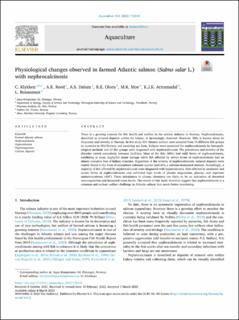| dc.contributor.author | Klykken, Christine | |
| dc.contributor.author | Reed, A.K. | |
| dc.contributor.author | Dalum, Alf Seljenes | |
| dc.contributor.author | Olsen, Rolf Erik | |
| dc.contributor.author | Moe, Morten Kaare | |
| dc.contributor.author | Attramadal, Kari | |
| dc.contributor.author | Boissonnot, Lauris Jeannine Ernestine | |
| dc.date.accessioned | 2023-02-07T08:53:38Z | |
| dc.date.available | 2023-02-07T08:53:38Z | |
| dc.date.created | 2022-04-13T14:14:00Z | |
| dc.date.issued | 2022 | |
| dc.identifier.citation | Aquaculture. 2022, 554 1-10. | en_US |
| dc.identifier.issn | 0044-8486 | |
| dc.identifier.uri | https://hdl.handle.net/11250/3048752 | |
| dc.description.abstract | There is a growing concern for fish health and welfare in the salmon industry in Norway. Nephrocalcinosis, described as mineral deposits within the kidney, is increasingly observed. However, little is known about its frequency and severity in Norway. In this study 810 Atlantic salmon were sampled from 14 different fish groups in nurseries in Mid-Norway and receiving sea farm. Kidneys were examined for nephrocalcinosis by histopathological methods and all fish groups were diagnosed with nephrocalcinosis. The prevalence and severity of the disorder varied extensively between facilities. Most of the fish (68%) had mild forms of nephrocalcinosis, exhibiting at most, negligible tissue damage while fish affected by severe forms of nephrocalcinosis had an almost complete loss of kidney structure. Regardless of the severity of nephrocalcinosis, mineral deposits were mainly found in the form of amorphous cabonate apatite (amCAP), a calcium-dominated mineral. Accordingly, a majority of fish affected by nephrocalcinosis were diagnosed with hypercalcemia. Fish affected by moderate and severe forms of nephrocalcinosis also exhibited high levels of plasma magnesium, glucose, and aspartate aminotransferase (AST). These imbalances in plasma chemistry are likely to be an indication of disturbed osmoregulation and increased stress levels. The results of this study therefore suggest that nephrocalcinosis is a common and serious welfare challenge in Atlantic salmon that needs better monitoring. | en_US |
| dc.language.iso | eng | en_US |
| dc.publisher | Elsevier Science | en_US |
| dc.rights | Attribution-NonCommercial-NoDerivatives 4.0 Internasjonal | * |
| dc.rights.uri | http://creativecommons.org/licenses/by-nc-nd/4.0/deed.no | * |
| dc.title | Physiological changes observed in farmed Atlantic salmon (Salmo salar L.) with nephrocalcinosis | en_US |
| dc.title.alternative | Physiological changes observed in farmed Atlantic salmon (Salmo salar L.) with nephrocalcinosis | en_US |
| dc.type | Peer reviewed | en_US |
| dc.type | Journal article | en_US |
| dc.description.version | publishedVersion | en_US |
| dc.source.pagenumber | 1-10 | en_US |
| dc.source.volume | 554 | en_US |
| dc.source.journal | Aquaculture | en_US |
| dc.identifier.doi | 10.1016/j.aquaculture.2022.738104 | |
| dc.identifier.cristin | 2017206 | |
| dc.relation.project | Fiskeri- og havbruksnæringens forskningsfinansiering: 901587 | en_US |
| dc.relation.project | Norges forskningsråd: 237856 | en_US |
| dc.relation.project | Norges forskningsråd: 304498 | en_US |
| cristin.ispublished | true | |
| cristin.fulltext | original | |
| cristin.qualitycode | 2 | |

